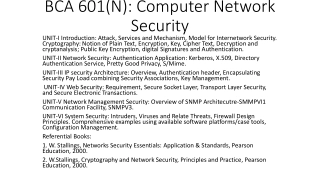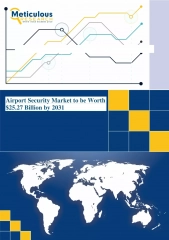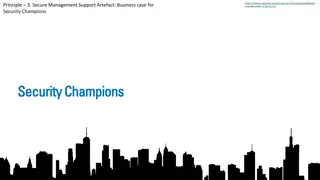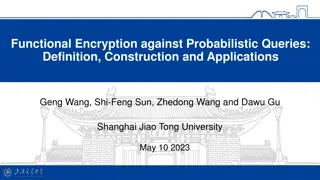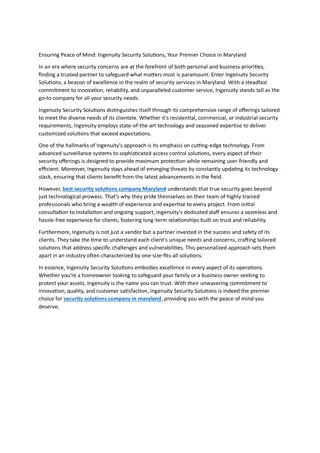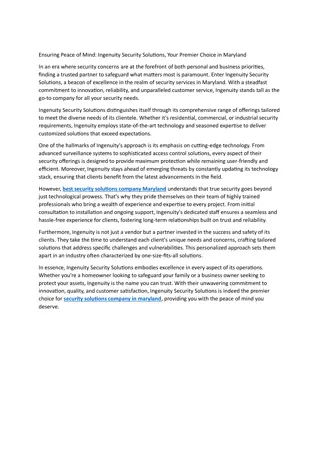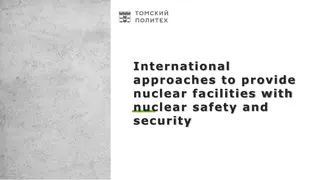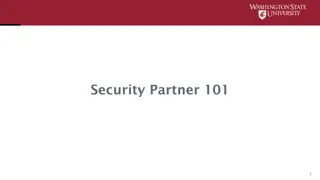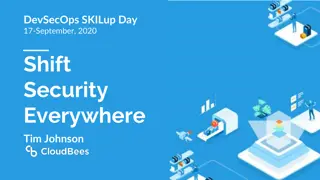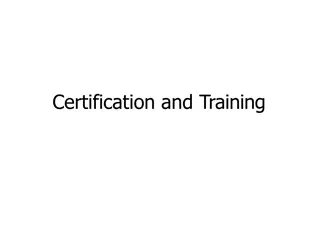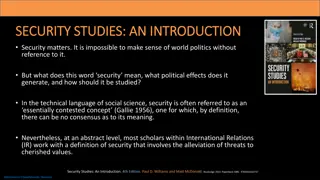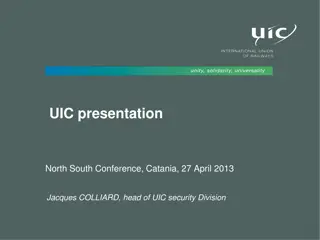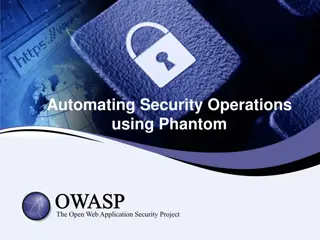
Understanding Security Principles and Practices
Explore the fundamental concepts of security theory, access control, encryption, and authentication. Learn about the principle of least privilege, authorization with intermediaries, and challenges in user authentication. Discover how these principles and practices come together to strengthen security in the digital realm.
Download Presentation

Please find below an Image/Link to download the presentation.
The content on the website is provided AS IS for your information and personal use only. It may not be sold, licensed, or shared on other websites without obtaining consent from the author. If you encounter any issues during the download, it is possible that the publisher has removed the file from their server.
You are allowed to download the files provided on this website for personal or commercial use, subject to the condition that they are used lawfully. All files are the property of their respective owners.
The content on the website is provided AS IS for your information and personal use only. It may not be sold, licensed, or shared on other websites without obtaining consent from the author.
E N D
Presentation Transcript
Security: Principles and Practice
Question Can you write a self-replicating C program? program that when run, outputs itself without reading any input files! ex: main() { printf( main () { printf( main ()
Main Points Security theory Access control matrix Passwords Encryption Security practice Example successful attacks
Security: Theory Principals Users, programs, sysadmins, Authorization Who is permitted to do what? Authentication How do we know who the user is? Encryption Privacy across an insecure network Authentication across an insecure network Auditing Record of who changed what, for post-hoc diagnostics
Authorization Access control matrix For every protected resource, list of who is permitted to do what Example: for each file/directory, a list of permissions Owner, group, world: read, write, execute Setuid: program run with permission of principal who installed it Smartphone: list of permissions granted each app
Principle of Least Privilege Grant each principal the least permission possible for them to do their assigned work Minimize code running inside kernel Minimize code running as sysadmin Practical challenge: hard to know what permissions are needed in advance what permissions should be granted Ex: to smartphone apps Ex: to servers
Authorization with Intermediaries Trusted computing base: set of software trusted to enforce security policy Servers often need to be trusted E.g.: storage server can store/retrieve data, regardless of which user asks Implication: security flaw in server allows attacker to take control of system
Authentication How do we know user is who they say they are? Try #1: user types password User needs to remember password! Short passwords: easy to remember, easy to guess Long passwords: hard to remember
Question Where are passwords stored? Password is a per-user secret In a file? Anyone with sysadmin permission can read file Encrypted in a file? If gain access to file, can check passwords offline If user reuses password, easy to check against other systems Encrypted in a file with a random salt? Hash password and salt before encryption, foils precomputed password table lookup
Encryption Sender Plaintext (M) Receiver Plaintext (M) Ciphertext (C) Encrypt E(M,KE) Decrypt D(C, KD) Cryptographer chooses functions E, D and keys KE, KD Suppose everything is known (E, D, M and C), should not be able to determine keys KE, KDand/or modify msg provides basis for authentication, privacy and integrity
Symmetric Key (DES, IDEA) Plaintext Plaintext Encrypt with symmetric key Decrypt with symmetric key Ciphertext Single key (symmetric) is shared between parties, kept secret from everyone else Ciphertext = (M)^K; Plaintext = M = ((M)^K)^K if K kept secret, then both parties know M is authentic and secret
Public Key (RSA, PGP) Plaintext Plaintext Encrypt with public key Decrypt with private key Secret Ciphertext Keys come in pairs: public and private Each principal gets its own pair Public key can be published; private is secret to entity can t derive K-private from K-public, even given M, (M)^K-priv
Public Key: Authentication Plaintext Plaintext Encrypt with PRIVATE key Decrypt with PUBLIC key Authentic ciphertext Keys come in pairs: public and private M = ((M)^K-private)^K-public Ensures authentication: can only be sent by sender
Public Key: Secrecy Plaintext Plaintext Encrypt with PUBLIC key Decrypt with Private key Secret ciphertext Keys come in pairs: public and private M = ((M)^K-public)^K-private Ensures secrecy: can only be read by receiver
Encryption Summary Symmetric key encryption Single key (symmetric) is shared between parties, kept secret from everyone else Ciphertext = (M)^K Public Key encryption Keys come in pairs, public and private Secret: (M)^K-public Authentic: (M)^K-private
Two Factor Authentication Can be difficult for people to remember encryption keys and passwords Instead, store K-private inside a chip use challenge-response to authenticate smartcard Use PIN to prove user has smartcard a smartcard
Public Key -> Session Key Public key encryption/decryption is slow; so can use public key to establish (shared) session key assume both sides know each other s public key client server client ID, x ((K,y,x+1)^C-public)^S-priv client authenticates server (y+1)^K server authenticates client
Symmetric Key -> Session Key In symmetric key systems, how do we gain a session key with other side? infeasible for everyone to share a secret with everyone else solution: authentication server (Kerberos) everyone shares (a separate) secret with server server provides shared session key for A <-> B everyone trusts authentication server if compromise server, can do anything!
Kerberos Example Server B A (A<->B, Kab)^Ksb
Message Digests (MD5, SHA) Cryptographic checksum: message integrity Typically small compared to message (MD5 128 bits) One-way : infeasible to find two messages with same digest Message (padded) Initial digest 512 bits 512 bits 512 bits Transform Transform Transform Message digest
Security Practice In practice, systems are not that secure hackers can go after weakest link any system with bugs is vulnerable vulnerability often not anticipated usually not a brute force attack against encryption system often can t tell if system is compromised hackers can hide their tracks can be hard to resecure systems after a breakin hackers can leave unknown backdoors
Tenex Password Attack Early system supporting virtual memory Kernel login check: for (i = 0; i < password length; i++) { if (password[i] != userpwd[i]) return error; } return ok
Internet Worm Used the Internet to infect a large number of machines in 1988 password dictionary sendmail bug default configuration allowed debug access well known for several years, but not fixed fingerd: finger tom@cs fingerd allocated fixed size buffer on stack copied string into buffer without checking length encode virus into string! Used infected machines to find/infect others
Ping of Death IP packets can be fragmented, reordered in flight Reassembly at host can get fragments out of order, so host allocates buffer to hold fragments Malformed IP fragment possible offset + length > max packet size Kernel implementation didn t check Was used for denial of service, but could have been used for virus propagation
UNIX talk UNIX talk was an early version of Internet chat For users logged onto same machine App was setuid root Needed to write to everyone s terminal But it had a bug Signal handler for ctl-C
Netscape How do you pick a session key? Early Netscape browser used time of day as seed to the random number generator Made it easy to predict/break How do you download a patch? Netscape offered patch to the random seed problem for download over Web, and from mirror sites four byte change to executable to make it use attacker s key
Code Red/Nimda/Slammer Dictionary attack of known vulnerabilities known Microsoft web server bugs, email attachments, browser helper applications, used infected machines to infect new machines Code Red: designed to cause machines surf to whitehouse.gov simultaneously Nimda: Left open backdoor on infected machines for any use Infected ~ 400K machines Slammer: Single UDP packet on MySQL port Infected 100K+ vulnerable machines in under 10 minutes Million node botnets now common
More Examples Housekeys ATM keypad Automobile backplane Pacemakers
Thompson Virus Ken Thompson self-replicating program installed itself silently on every UNIX machine, including new machines with new instruction sets
Add backdoor to login.c Step 1: modify login.c A: if (name == ken ) { don t check password; login ken as root; } Modification is too obvious; how do we hide it?
Hiding the change to login.c Step 2: Modify the C compiler B: if see trigger { insert A into the input stream } Add trigger to login.c /* gobblygook */ Now we don t need to include the code for the backdoor in login.c, just the trigger But still too obvious; how do we hide the modification to the C compiler?
Hiding the change to the compiler Step 3: Modify the compiler C: if see trigger2 { insert B and C into the input stream } Compile the compiler with C present now in object code for compiler Replace C in the compiler source with trigger2
Compiler compiles the compiler Every new version of compiler has code for B,C included as long as trigger2 is not removed and compiled with an infected compiler if compiler is for a completely new machine: cross- compiled first on old machine using old compiler Every new version of login.c has code for A included as long as trigger is not removed and compiled with an infected compiler
Question Can you write a self-replicating C program? program that when run, outputs itself without reading any input files! char *buf = "char *buf = %c%s%c; main(){printf(buf, 34, buf, 34);}"; main() { printf(buf, 34, buf, 34); }
Security Lessons Hard to re-secure a machine after penetration how do you know you ve removed all the backdoors? Hard to detect if machine has been penetrated Western Digital example Any system with bugs is vulnerable and all systems have bugs: fingerd, ping of death, Code Red, nimda,

